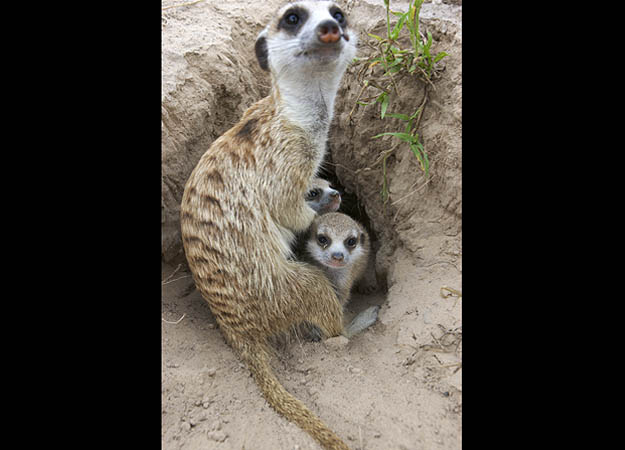Sentinel Behavior in Meerkats
Biology 342 Fall 2010
Amber Bang and Mischka Moechtar
Phylogeny

Babysitting a pair or meerkat pups. Photo courtesy of Animal Planet's Meerkat Manor
What is phylogeny?
The implications encapsulated within the category of "Phylogeny", which is a component of Tinbergen’s Four Questions, can also be described by the term "evolution". Phylogeny can help us find different ways to describe the history of the behavior, such as which ancestor first possessed this trait, what was the antecedent to this behavior, and what selective pressures in the past have shaped this behavior.
Phylogenetic Theories
Several theories exist to explain the evolutionary significance of guarding behavior. This is due to the as of yet undetermined motivation behind why meerkats choose to guard despite possible risks of such a position. Some research still supports various altruistic mechanisms including kin selection (Hamilton 1964) and reciprocal altruism (Zahavi and Zahavi 1997). There also exists the opposing theory of selfish sentinels (Bednekoff 1997).
Kin Selection
Kin selection is presented as an evolutionary strategy that favors the reproductive success of an individual's relatives, though not necessarily that of the individual (Hamilton 1964). This theory also corresponds with the idea of the “selfish gene”, which postulates that an individual is programmed genetically to ensure the proliferation of related genes through progeny that does not necessarily have to be its own. Hamilton’s Rule theorizes that gene frequency should increase when:
![]()
r = the genetic relatedness of the recipient to the actor, often defined as the probability that a gene picked randomly from each at the same locus is identical by descent
B = the additional reproductive benefit gained by the recipient of the altruistic act
C = the reproductive cost to the individual performing the act
This rule has popularly been applied to naked mole rates, another cooperatively breeding species.
Reciprocal Altruism
Reciprocal altruism corresponds to the idea of eventual delayed benefit from those members of the community benefited by an individual's acts of altruism. Zahavi’s studies with Arabian babblers and sentinel behavior suggest such risky behavior to be a mechanism by which those individuals showcase their social status by garnering respect from other group members. In this way, the cooperative behavior is providing direct benefits to the altruist, as well as indirect benefits to the group (Zahavi and Zahavi 1997).
The Safe, Selfish Sentinel
This theory proposed by Bednekoff posits that individuals who choose to guard are selfishly motivated by direct benefit to themselves, and as a secondary result benefit the community through threat alert alarm calling (Bednekoff 1997). As Clutton-Brock, et al. demonstrated with their groundbreaking paper in 1999, meerkat sentinels actually are able to reach safety more quickly than those that are foraging, which thus provides direct benefit to the sentinel. Furthermore, Bednekoff asserts that sentinels are more likely motivated to assume the role when they are fully satiated. The kin selection model then applies here to the indirect benefits attained through this behavior, as the reproductive success of other group members is enhanced as a result.
And Yet…
However, none of these hypotheses have been thoroughly supported by significant evidence, and no fully accepted explanation for the evolutionary function of the sentinel behavior observed in meerkats exists as of yet.
Mongoose Relatives?
Some mongoose species tend to live solitarily, while others in fact are quite social and exhibit similar ways of cooperative living and sentinel behavior. Such mongoose relatives that do present behaviors similar to meerkats include those of the common dwarf mongoose (Figure1) and the banded mongoose, both of which are in the same Herpestidae family as meerkats. The banded mongoose has in fact been known to use “cooperative begging” (Bell 2007).

Figure 1. Dwarf Mongoose On Guard (James Warwick)